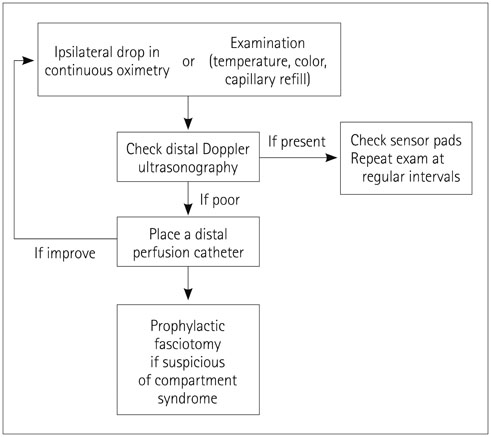J Korean Soc Radiol.
2016 Jun;74(6):373-379. 10.3348/jksr.2016.74.6.373.
Safety and Efficacy of Distal Perfusion Catheterization to Prevent Limb Ischemia after Common Femoral Artery Cannulation for Extracorporeal Membrane Oxygenation
- Affiliations
-
- 1Department of Radiology, Seoul National University Bundang Hospital, Seongnam, Korea. nextblood@gmail.com
- 2Department of Radiology, Seoul National University College of Medicine, Seoul, Korea.
- KMID: 2164814
- DOI: http://doi.org/10.3348/jksr.2016.74.6.373
Abstract
- PURPOSE
The extracorporeal membrane oxygenation (ECMO) cannula has the potential for obstructing flow to the lower limb, thus causing severe ischemia and possible limb loss. We evaluated the safety and clinical efficacy of percutaneous distal perfusion catheterization in preventing limb ischemia.
MATERIALS AND METHODS
Between March 2013 and February 2015, 28 patients with distal perfusion catheterization after ECMO were included in this retrospective study. The technical success was evaluated by Doppler ultrasound at the popliteal level after saline injection via distal perfusion catheter. Clinical success was assessed when at least one of the following conditions was met: restoration of continuous peripheral limb oximetry value or presence of distal arterial pulse on Doppler ultrasound evaluation or resolution of early ischemic sign after connecting the catheter with ECMO.
RESULTS
Twenty-six patients with early ischemia were successfully cannulated with a distal perfusion catheter (92.8%). Clinical success was achieved in 12/28 (42.8%) patients; 8/10 (80.0%) patients with survival duration exceeding 7 days and 4/18 (22.2%) patients with survival duration less than 7 days, respectively.
CONCLUSION
A percutaneous distal perfusion catheter placement was a feasible tool with safety and efficacy in preventing lower limb ischemia for patients with prolonged common femoral arterial cannulation for ECMO.
MeSH Terms
Figure
Reference
-
1. Doll N, Kiaii B, Borger M, Bucerius J, Krämer K, Schmitt DV, et al. Five-year results of 219 consecutive patients treated with extracorporeal membrane oxygenation for refractory postoperative cardiogenic shock. Ann Thorac Surg. 2004; 77:151–157. discussion 157.2. Massetti M, Tasle M, Le Page O, Deredec R, Babatasi G, Buklas D, et al. Back from irreversibility: extracorporeal life support for prolonged cardiac arrest. Ann Thorac Surg. 2005; 79:178–183. discussion 183-184.3. Hemmila MR, Rowe SA, Boules TN, Miskulin J, McGillicuddy JW, Schuerer DJ, et al. Extracorporeal life support for severe acute respiratory distress syndrome in adults. Ann Surg. 2004; 240:595–605. discussion 605-607.4. Schwarz B, Mair P, Margreiter J, Pomaroli A, Hoermann C, Bonatti J, et al. Experience with percutaneous venoarterial cardiopulmonary bypass for emergency circulatory support. Crit Care Med. 2003; 31:758–764.5. Phillips SJ, Zeff RH, Kongtahworn C, Skinner JR, Toon RS, Grignon A, et al. Percutaneous cardiopulmonary bypass: application and indication for use. Ann Thorac Surg. 1989; 47:121–123.6. Gander JW, Fisher JC, Reichstein AR, Gross ER, Aspelund G, Middlesworth W, et al. Limb ischemia after common femoral artery cannulation for venoarterial extracorporeal membrane oxygenation: an unresolved problem. J Pediatr Surg. 2010; 45:2136–2140.7. Hendrickson SC, Glower DD. A method for perfusion of the leg during cardiopulmonary bypass via femoral cannulation. Ann Thorac Surg. 1998; 65:1807–1808.8. Cheng R, Hachamovitch R, Kittleson M, Patel J, Arabia F, Moriguchi J, et al. Complications of extracorporeal membrane oxygenation for treatment of cardiogenic shock and cardiac arrest: a meta-analysis of 1,866 adult patients. Ann Thorac Surg. 2014; 97:610–616.9. Bisdas T, Beutel G, Warnecke G, Hoeper MM, Kuehn C, Haverich A, et al. Vascular complications in patients undergoing femoral cannulation for extracorporeal membrane oxygenation support. Ann Thorac Surg. 2011; 92:626–631.10. Greason KL, Hemp JR, Maxwell JM, Fetter JE, Moreno-Cabral RJ. Prevention of distal limb ischemia during cardiopulmonary support via femoral cannulation. Ann Thorac Surg. 1995; 60:209–210.11. Madershahian N, Nagib R, Wippermann J, Strauch J, Wahlers T. A simple technique of distal limb perfusion during prolonged femoro-femoral cannulation. J Card Surg. 2006; 21:168–169.12. Rao AS, Pellegrini RV, Speziali G, Marone LK. A novel percutaneous solution to limb ischemia due to arterial occlusion from a femoral artery ECMO cannula. J Endovasc Ther. 2010; 17:51–54.13. Sacks D, McClenny TE, Cardella JF, Lewis CA. Society of Interventional Radiology clinical practice guidelines. J Vasc Interv Radiol. 2003; 14(9 Pt 2):S199–S202.14. Vander Salm TJ. Prevention of lower extremity ischemia during cardiopulmonary bypass via femoral cannulation. Ann Thorac Surg. 1997; 63:251–252.15. Kasirajan V, Simmons I, King J, Shumaker MD, DeAnda A, Higgins RS. Technique to prevent limb ischemia during peripheral cannulation for extracorporeal membrane oxygenation. Perfusion. 2002; 17:427–428.16. Rastan AJ, Dege A, Mohr M, Doll N, Falk V, Walther T, et al. Early and late outcomes of 517 consecutive adult patients treated with extracorporeal membrane oxygenation for refractory postcardiotomy cardiogenic shock. J Thorac Cardiovasc Surg. 2010; 139:302–311. 311.e117. O'Connor TA, Haney BM, Grist GE, Egelhoff JC, Snyder CL, Ashcraft KW. Decreased incidence of intracranial hemorrhage using cephalic jugular venous drainage during neonatal extracorporeal membrane oxygenation. J Pediatr Surg. 1993; 28:1332–1335.
- Full Text Links
- Actions
-
Cited
- CITED
-
- Close
- Share
- Similar articles
-
- A Patient with Multiple Unfavorable Reconstruction Options: What Is the Best Choice?
- Five-year Experience of Extracorporeal Life Support in Emergency Physicians
- Successful Retrieval of a Fractured Guidewire during Extracorporeal Membrane Oxygenator Insertion
- Extracorporeal Membrane Oxygenation for 67 Days as a Bridge to Heart Transplantation in a Postcardiotomy Patient with Failing Heart and Mediastinitis
- Iatrogenic Iliac Vein Injury Following Extracorporeal Membrane Oxygenation Cannulation in a Patient with May-Thurner Syndrome: A Case Report and Literature Review




